- Home
- Julian May
The Many-Colored Land Page 9
The Many-Colored Land Read online
Page 9
The room light faded and the tapestry rose to reveal a large holograph screen. There was music. (Lord Jesus, thought Elizabeth. Not Stravinsky!) The screen went from black to living Tri-D color in an orbiter's view of Pliocene Earth, six million years—give or take a few—backward in time.
In a long shot, it looked pretty familiar. But then the lens zoomed in.
Mishima said, "The continents, you will observe, are in their approximate modern positions. However, their outlines have an unfamiliar aspect, primarily because shallow epicontinental seas still covered some areas, while others, now lying underwater, were then dry land."
The globe rotated slowly and stopped when Europe was well positioned. The lens zoomed in closer and closer.
"You will all be furnished with a set of durofilm maps—small-scale for the entire Lower Pliocene Earth, one-to-seven-million of Europe, and one-to-one-million of France. Should you plan an excursion to other parts of the world or simply have an interest in them, we will do our utmost to provide you with suitable maps or marine charts."
"How accurate will they be?" asked the pirate.
"Extremely so, we believe." Mishima's response was smooth. "The Pliocene being one of the most recent geological epochs, our computers have been able to map its topography with an accuracy that must approach eighty-two percent. The areas most speculatively derived include fine details of the littoral, minor watercourses, and certain aspects of the Mediterranean Basin."
He began to show them closeup views of different areas, all in vivid relief and supplemented by an outline overlay of the modern landform.
"The British Isles are fused into a single very large mass, Albion, which is probably joined by a narrow isthmus to Normandy. The Low Country area is submerged by the Anversian Sea, as is northwestern Germany. Fennoscandia is an unbroken unit, as yet unsundered by the Baltic. Poland and Russia are strewn with swamps and lakes—some quite large. Another great body of fresh water lies southwest of the Vosges in France, and there are large Alpine lakes..."
To the east, the land looked almost completely unfamiliar. A brackish lagoon, the Pannonian Basin, covered Hungary and drained through the Iron Gate and the Dacian Strait to a shallow remnant of the once dominant Tethys Sea, also called Lac Mer. This spread swampy lagoons and salt water far into Central Asia and northward to the iceless Boreal Ocean. In years to come, only the Aral and the Caspian Seas would remain as souvenirs of the vanished Tethys.
"Note also that the Euxinic Basin, which will someday become the Black Sea, is also fresh water. It is fed by the towering ranges of Caucasia, Anatolia, and the Helvetides to the west. A vast swamp occupies the area of the modern Sea of Marmara. Below this is Lake Levant, roughly corresponding to the Aegean Sea of today."
"The Med looks pretty mixed up to me," the Viking observed. "In my line of work I had to know something about the crazy geology of that region. It seems to me you gotta be doing a whole lotta guessing to come up with that layout there."
Mishima acknowledged the point. "There are problems connected with the chronology of the successive Mediterranean inundations. We believe this configuration is most plausible for the early Pliocene. Please observe that the now vanished peninsula of Balearis juts eastward from Spain. There is a single narrow island in place of modern Corse and Sardegna. Italy during that time has only its Apennine spine above sea level, together with an unstable southern area called Tyrrhenis, which once was much larger but now is sinking."
He gave them a closer view of western Europe.
"This is the region that should be of immediate interest to you. The Rhône-Saône Trough contains a great river, draining swamps north of Switzerland and the large Lac de Bresse. The lower Rhône Valley of Pliocene times was probably invaded by the Mediterranean. Many of the volcanoes in the Massif Central were active, and there was also vulcanism in Germany, Spain, central Italy, and in the subsiding Tyrrhenian area. Farther north in France, we see that Brittany is an island separated from the mainland by the narrow Strait of Redon. The Atlantic forms a deep embayment southward into Anjou. Part of Gascony is also inundated by the sea."
"But Bordeaux seems to be all right, thank God," said the pirate.
Mishima chuckled. "Ah! Another connoisseur! You will be delighted to know, Citizen, that a number of other timefarers expressed a wish to settle in the Bordeaux area. They have carried with them certain portable apparatus and cuttings of many different grapes ... Incidentally, Citizens, such information as we have about these earlier time-travelers is available from our computer at your convenience. And if you wish to have other information—for example, data on religious or ethnic groups, or on the kinds of books, art matériel, or other cultural items known to have been translated—please do not hesitate to request it."
The academic type in the tweed jacket asked, "Will the computer give information on individual persons?"
Aha! thought Elizabeth.
"The usual statistics, similar to those in your own dossiers, are available on those persons who have already passed through. It is also possible to obtain information on the items taken as baggage and the traveler's destination in the Pliocene world, if stated."
"Thank you."
"If there are no further questions—?" Mishima nodded to Felice, who had raised a languid hand.
"Is it true that none of these travelers took any weapons with them?"
"No modern weapons were allowed by Madame Guderian, and we have followed her wise dictum. No zappers, no stun-guns, no atomics, no sonic disruptors, no solar-powered blasters, no gases, no gunpowder-based weapons. No psychocoercive drugs or devices. However, many kinds of primitive weaponry from different eras and cultures have been taken into the Pliocene."
Landry nodded. Her face was void of expression. Elizabeth tried, without realizing what she was doing, to throw a redactive probe into her, but of course it was useless. Nevertheless, the ex-metapsychic was amazed when the young woman turned her head and stared directly at her for a long minute before looking back at the screen.
She couldn't have felt anything, Elizabeth told herself. There was nothing to feel. And even if the carrier went out, there's no way she could have known that it was me. Was there?
Counselor Mishima said, "Let us briefly note some of the names that have been given to the geographical features. Then we will survey the plant and animal life of the so-called Pontian Facies of Lower Pliocene times..."
14
JUST AS SOON as the lecture ended, Grenfell hurried to his room and the computer terminal, which was housed in a renaissance credence of wormy fruitwood. He requested the data in permanent durofilm sheets, not really knowing what to expect. What did emerge was pathetically meager—but it unexpectedly included a full-length color portrait, probably taken just prior to her passing through the gate.
Mercy Lamballe was wearing a cowled cloak of deep reddish brown that concealed most of her auburn hair and made dark pits of her eyes. Her face was white and strained. The dress was long, simply cut, of Nile green with a trimming of gold embroidery about the neck, wrists, and hem. Her narrow waist was held in a girdle of some dark color, from which hung a purse and a small scabbard with unidentifiable instruments in it. She wore gold bracelets and a gold necklace, both with purple stones. A large brocaded valise sat beside her. She carried a covered basket and a leather case that looked as though it held a small harp.
She was accompanied by a huge white dog wearing a spiked collar, and four sheep.
He stared at the picture for some time, memorizing it while his eyes stung. Then he read her tersely summarized dossier:
LAMBALLE, MERCEDES SIOBHAN 8-∅49-333-∅32-421F. B: St.-Brieuc 48:31 N, ∅2:45W, FrEu, Sol-3 (Earth), 15-5-2∅82, d. Georges Bradford Lamballe 3-946-2∅2-664-117 & Siobhan Maeve O'Connell 3-429-697-551-418. Sb: ∅. M: ∅. D: ∅. C: ∅. Phy: H17∅cm, W46kg, Sfr1, Hrd2, Egn4, DMmole Rscap. Men: IA+ 146( + 3B2), PSA+5+4.2+3.∅-∅.7+6.1, MPQ-.∅79(L)+28+ 6+133 + 468 + 1. MedHist:NSI, NST, NSS (Suppl). PsyHist: AlienRefr-4 (
non-dis), Fug-5 (non-dis), MDep-2 (.25 dis UT) (Supp2). Ed: BA Paris 21∅2, MA(Anthr) Oxon 21∅3, PhD(Fr-MedHis) Paris 21∅4, DLH(CeltFL) Dublin 21∅5. Emp: ImPag Eire (T4-T1) ∅5-∅8;(DirAsst3-2) ∅8-∅9. ImPag France (DirAsstl) ∅9-1∅. Res: 25a Hab Cygne, Riom 45:54N, ∅3:∅7E, FrEu, Soi-3. CivSt:*1*A-∅∅1∅. CrRt: A-∅1-3. Lie: E3, Tv, Ts, E1Tc2, Dg.
REMARKS: Ent: 1∅-5-211∅. VocOpt: Dyer, Sheep Husb, Smallholder, Weaver, Wool Tech. Perslnv: (Supp3). Dest: NS. Attmt: NS.
TRANS: 15-5-211∅ REF: J. D. Evans GC2
SUPPLEMENT 3 Personal Inventory, Lamballe, M. S.
Clothing: Gown, silk, gm emb-Au. Gown, silk, w emb-r+grn. Gown, polchro, blk emb-Ag-myl Scarves, silk, 3. Cloak, repelvel, terracotta Smalls, silk, asst w, 3sts. Hose, silk, w, 3pr Shoes, low, leather, 2pr. Belt, leather. Purse leather. Chatelaine, leather + scissors knife, file, comb, stylus, fork, spoon.
Baggage: Survival Unit A-6* Smallholder Unit F-1*. Sheep Kit Ov-1*. Fleck, Music, 5Ku, w/AVP (Supp4). Fleck, Library, 1∅Ku, w/AVP (Supp5). Decamole appi: spin-wheel, hand-spindle, carder, loom L4H, dye-tub. Valise, leather-brocade. Basket, esparto, cov. Necklace, Au & amethyst. Bracelets, Au & amethyst, 3. Ring, Au & pearl. Mirror, Ag, 1∅cm. Noteplaque, 1Ku. Sewkit S-1* . Harp, gilt carved sycamore wood, Celtic, w/case, leather. Harp strings & pegs, asst spare. Fife, open, Ag.
Plants: Strawberry "Hautbois Supérieur 12e," 1∅∅ pts. Hemp (Cannabis s. sinsemilla) 15 ctgs. CulHb Unit CH-1*. SmGrain Unit SG-1* . Mise seed pkts: Bluebell (Campanula bel-lardi), Indigo (Indigofera tinctoria), Madder (Rubia tinctorum), Pea "Mangetout."
Animals: Chien des Pyrénées, "Bidarray's Deirdre Stella-Polaris" (1F, pr4M+4F). Sheep, Rambouillet × Débouillet (3F@ pr2F; 1M).
There was more—the supplements with details of her medical and psychiatric history, the library supplements listing her music and books. He skimmed these, then returned to the poignant inventory and the portrait.
Will I find you again, Mercy in your silken gown and golden jewelry, with your harp and your fife and your strawberries and bluebells? Where will you go to tend your pregnant sheep? (Dest: NS.) Will I find you alone, except for loyal Dierdre and her pups, as you've always lived? (Attmt: NS.) Will you welcome me and teach me the songs of old Languedoc or old Ireland, or will your heartswound still be too deep for me to fill? (MDep-z, .25 dis UT.)
What did you find on the other side of the time-portal when you stepped through on your birthday, beginning your twenty-ninth year of life six million years before you were born? And why am I leaving this bravest of all new worlds for a constricting unknown? What's in the dark that I'm so afraid of finding/not finding?
Beguiled my heart, I know not why. And yet I love her till I die.
15
CLAUDE MAJEWSKI opened his eyes, wiped the rheum out of them with a tissue, and removed the earplug that had been teaching him while he slept how to mortise wind beams into the rafters of a log cabin. His left arm was full of pins and needles and his feet were cold. Damn crocky old circulation shot to hell. As he kneaded the blood back into the muscles, he reflected that he would miss the luxury of the auberge's goosedown pillows, liquicelle mattress, and real muslin sheets. He hoped the survival kit they would test today had a decent camp bed.
He padded across the sunny room to the bath. Here the compassion of Madame Guderian was made manifest in black-and-white marble and golden plumbing, in thick towels, perfumed soap and toiletries by Chanel, in sauna and sunlamp and la Masseuse ready to cradle the clients of the inn in soothing elegance after sobering lessons in la vie sauvage.
Some poor timefarers-struggling to endure the Pliocene world would remember the last days at the auberge for French cooking, soft beds, and precious works of art. But Majewski knew that his fondest memories would be of the sybaritic john. The warm padded seat that welcomed his spindly shanks! The tissue, like perforated rabbit fur! He harked back to some of the primitive conveniences he and Gen had suffered on boondock planets—portacans with broken heating units; noisome stone and wood tillyhouses full of lurking critters; rough two-holers over flooded trenches; even one ghastly night of storms on Lusatia when he had squatted on a log and then discovered that it harbored little mitey monstrosities.
O blessed sanitary plumbing! If no one else invented a Pliocene water closet, Claude intended to give it an earnest shot.
He had a cool perfumed shower, cleaned his teeth (third set, good as new), made a face at himself in the Louis XIV mirror. Not too decrepit. A casual appraisal might judge his age to be late fiftyish. He was vain about his Polish green eyes and striking thatch of waved silver hair, the result of having the male-pattern baldness codons erased from his genetic heritage on the last rejuv. But thank God he'd depilated the rest of his pelt! Characters like that pirate who prized facial hair might have another song to sing in a primitive world—especially a warm and buggy one like Pontian Europe. The old paleobiologist had noted with grim humor that yesterday's lectures and clever animated movies on Pliocene ecology had barely mentioned the insects and other invertebrate denizens. It was more dramatic to show vast herds of hipparions and graceful gazelles being harried by scarcely less graceful cheetahs; or machairodont lions sinking their long canines into bellowing hoe-tuskers.
Claude went back into the bedroom and asked room service to send coffee and croissants. Since this second day was to feature simple survival techniques, he put on the clothing he planned to wear through the gate. Experience had made his choice of kit easy: fishnet underwear, old-fashioned bush shirt and pants made of the best Egyptian long-staple cotton, socks of Orcadian wool with the fat left in, and indestructible boots from Etruria. He had brought along his old backpack even though the auberge stood ready to furnish all equipment. It contained his poncho of breathable grintlaskin and an Orcadian sweater. And in one zip compartment was a beautiful Zakopane box, all carved and ornamented wood. Gen's box. It hardly weighed a thing.
As he breakfasted, he studied the program for the day's activities. Introduction to Survival Unit A-6*. Shelter and Fire. Minimizing Environmental Hazards (ho ho). Orienteering. Fishing and Trapping.
He sighed, drank the perfect coffee, and munched a flaky bread roll. It was going to be a long day.
16
SISTER ANNAMARIA ROCCARO had done a fair bit of camping, but the expensive new decamole equipment contained in Unit A-6* was a delight and a revelation to her.
She and the other members of Group Green had first gone to class, where a hearty woman instructor briefed them; then they had paired up and descended to a cavern carved out of the living rock 200 meters below the cellars of the auberge. They were let loose into a sunny meadow with a winding stream and told to become acquainted with their survival gear.
The simulated sun felt hot, even though the reset of their body thermostats was progressing apace. After she and Felice had hiked a short distance, Amerie decided that she would have to forego the sandals that had been her first choice for Pliocene footgear. They were suitably monastic and airy, but they also admitted twigs and small stones. Short buskins or even modern boots would be better for cross-country travel. She also decided that the white doeskin habit was overwarm, even with detachable sleeves. Homespun would be better. She could have a doeskin scapular, cowl, and cloak to keep off the weather.
"Aren't you hot in that outfit, Felice?" she asked her companion. Landry was wearing the green-and-black ring-hockey uniform, which was evidently her choice for the Pliocene.
"It suits me," the girl said. "I'm used to working in it, and my planet was much warmer than Earth. That doeskin looks very high-priestess, Amerie. I like it."
The nun felt strangely flustered. Felice looked so incongruous in her warrior's cuirass and greaves and that Grecian helm with its brave green feathers perched on the back of her head. Stein and Richard had started to tease her when she appeared in the costume that morning; but for some reason, they had broken off almost immediately.
"Shall we camp here?" the nun suggested. A large cork oak grew beside the br
ook, shading a flat surface that looked like a good place to set up the cabin. The two women shed their packs, and Amerie extracted the fist-sized inflator from hers and studied it. Their instructor had said that the sealed power supply would be good for about twenty years. "Here are two nozzles, one to blow things up and the other to deflate. It says: IMPERATIVE TO SHEATH UNUSED NOZZLE."
"Try my cabin-pak." Felice held out a wad about the size of a sandwich. "I can't believe it'll grow into a four-by-four house."
Sister Roccaro fixed the dangling flat tube of the pak to the inflator, then pressed the activating stud. Compressed air began to spurt into the wad, turning it into a large silvery square. The two women positioned the cabin properly, then watched it grow. The floor thickened to about nine centimeters and became quite rigid as air filled the complex micropore structural web between the layers of film. The walls, somewhat thicker for insulation, grew up, complete with transparent zipable windows and interior screen-curtains. A steeply gabled silvery roof that overhung the doorway inflated last of all.
Felice peered inside the doorless entry. "Look. The floor has sprouted fixed furniture."
There were bunks for two with semidetached pillows, a table, shelves, and at the rear a silvery box with a pipe leading to the roof. Felice read aloud: "BALLAST STOVE WITH SAND OR UNIT WILL COMPRESS UPON COOLING ...This material must be nearly impossible to destroy!" She reached behind her left greave and produced a glittering little gold-handled dirk. "Can't puncture it, either."
"What a pity they've made it to degrade in twenty years. Still, we should be at one with our environment by then."
Large bucket-shaped hollows in each corner of the cabin had to be ballasted with stones, earth, water, or whatever else was to hand. A very small pocket near the door yielded up a whole handful of pill-sized wads that were to be inflated separately, then weighted with sand or with water. The latter could be injected into the interstitial area by means of a simple collapsible bulb siphon. The pills grew into a cabin door, chairs, cooking gear (with the sand-ballast note), filamentous rugs and blankets, and other miscellany. Less than ten minutes after they had begun to set up camp, the women were relaxing in a fully equipped cabin.

 The Many-Coloured Land
The Many-Coloured Land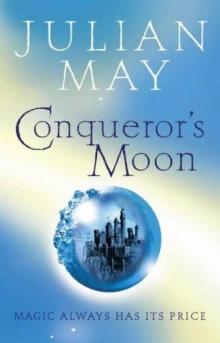 Conqueror's Moon
Conqueror's Moon The Sagittarius Whorl
The Sagittarius Whorl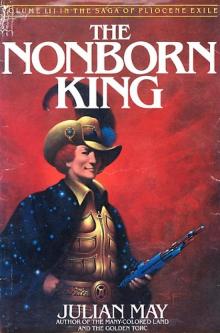 The Nonborn King
The Nonborn King Sky Trillium
Sky Trillium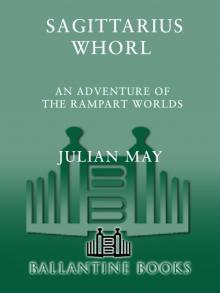 The Sagittarius Whorl: Book Three of the Rampart Worlds Trilogy
The Sagittarius Whorl: Book Three of the Rampart Worlds Trilogy Intervention
Intervention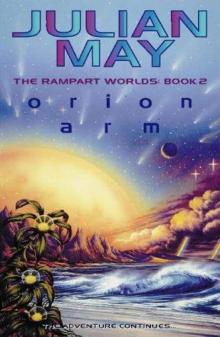 Orion Arm
Orion Arm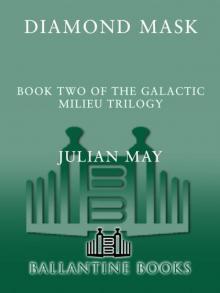 Diamond Mask
Diamond Mask The Golden Torc
The Golden Torc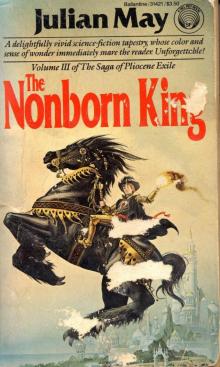 The Noborn King
The Noborn King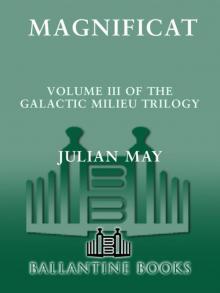 Magnificat
Magnificat Jack the Bodiless
Jack the Bodiless Perseus Spur
Perseus Spur The Adversary
The Adversary Sorcerer's Moon
Sorcerer's Moon Sagittarius Whorl
Sagittarius Whorl The Intervention (Omnibus)
The Intervention (Omnibus)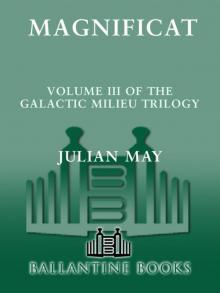 Magnificat (Galactic Milieu Trilogy)
Magnificat (Galactic Milieu Trilogy)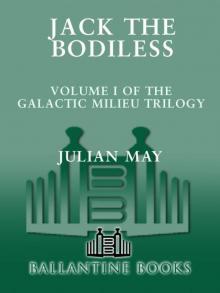 Jack the Bodiless (Galactic Milieu Trilogy)
Jack the Bodiless (Galactic Milieu Trilogy)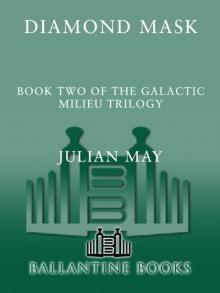 Diamond Mask (Galactic Milieu Trilogy)
Diamond Mask (Galactic Milieu Trilogy) The Many-Coloured Land sope-1
The Many-Coloured Land sope-1